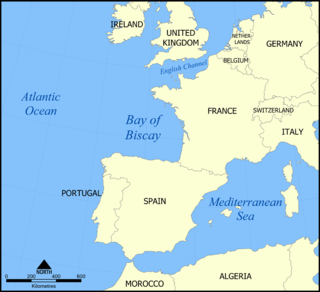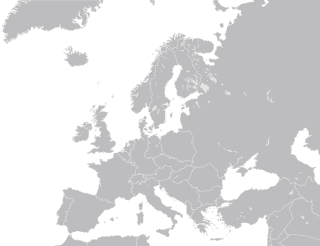
The Supreme Headquarters Allied Powers Europe (SHAPE) is the military headquarters of the North Atlantic Treaty Organization's (NATO) Allied Command Operations (ACO) that commands all NATO operations worldwide. SHAPE is situated in the village of Casteau, near Mons, Belgium.

The Home Fleet was a fleet of the Royal Navy that operated from the United Kingdom's territorial waters from 1902 with intervals until 1967. In 1967, it was merged with the Mediterranean Fleet creating the new Western Fleet.

The Commander-in-Chief Fleet (CINCFLEET) was the admiral responsible for the operations of the ships, submarines and aircraft of the British Royal Navy from 1971 until April 2012. The post was subordinate to the First Sea Lord, the professional head of the Naval Service. In its last years, as the Navy shrank, more administrative responsibilities were added.
Allied Command Operations (ACO) is one of the two strategic commands of the North Atlantic Treaty Organization (NATO), the other being Allied Command Transformation (ACT). The headquarters and commander of ACO is Supreme Headquarters Allied Powers Europe (SHAPE) and Supreme Allied Commander Europe (SACEUR), respectively.

Allied Forces Northern Europe (AFNORTH) was the northern Major Subordinate Command of NATO's Allied Command Europe (ACE), located at Kolsås outside Oslo. In the case of war with the Soviet Union, AFNORTH would assume supreme command of all Allied forces in northern Europe and Germany north of Elbe/Hamburg and adjacent sea territory.

Allied Command Transformation (ACT) is a military command of the North Atlantic Treaty Organization (NATO), formed in 2003 after restructuring.

Northwood Headquarters is a military headquarters facility of the British Armed Forces in Eastbury, Hertfordshire, England, adjacent to the London suburb of Northwood. It is home to the following military command and control functions:
- Headquarters, Strategic Command, formerly Joint Forces Command
- Permanent Joint Headquarters
- Commander Operations for the Royal Navy
- NATO Allied Maritime Command

The Joint Force CommandNaples is a NATO military command based in Lago Patria, in the Metropolitan City of Naples, Italy. It was activated on 15 March 2004, after effectively redesigning its predecessor command, Allied Forces Southern Europe (AFSOUTH), originally formed in 1951. In NATO Military Command Structure terms, AFSOUTH was a "Major Subordinate Command". The commander of JFC Naples reports to the Supreme Allied Commander Europe at the Supreme Headquarters Allied Powers Europe, Casteau, Belgium.

The Supreme Allied Commander Atlantic (SACLANT) was one of two supreme commanders of the North Atlantic Treaty Organisation (NATO), the other being the Supreme Allied Commander Europe (SACEUR). The SACLANT led Allied Command Atlantic was based at Norfolk, Virginia. The entire command was routinely referred to as 'SACLANT'.

Exercise Mainbrace was the first large-scale naval exercise undertaken by the newly established Allied Command Atlantic (ACLANT), one of the two principal military commands of the North Atlantic Treaty Organization (NATO). It was part of a series of NATO exercises jointly commanded by Supreme Allied Commander Atlantic Admiral Lynde D. McCormick, USN, and Supreme Allied Commander Europe General Matthew B. Ridgeway, U.S. Army, during the fall of 1952.

No. 18 Group of the Royal Air Force was a group active from 1918 to 1919, and from 1938 to 1996.

The Admiral Benelux (ABNL) is the Commanding Officer of the combined military staff of the Royal Netherlands Navy and the Naval Component of the Belgian Armed Forces.

Exercise Verity was the only major training exercise of the Western Union (WU). Undertaken in July 1949, it involved 60 warships from the British, French, Belgian and Dutch navies. A contemporary newsreel described this exercise as involving "the greatest assembly of warships since the Battle of Jutland."
The structure of the North Atlantic Treaty Organization (NATO) is complex and multi-faceted. The decision-making body is the North Atlantic Council (NAC), and the member state representatives also sit on the Defence Policy and Planning Committee (DPPC) and the Nuclear Planning Group (NPG). Below that the Secretary General of NATO directs the civilian International Staff, that is divided into administrative divisions, offices and other organizations. Also responsible to the NAC, DPPC, and NPG are a host of committees that supervise the various NATO logistics and standardisation agencies.

Royal Air Force Pitreavie Castle or RAF Pitreavie Castle was a station of the Royal Air Force located at Pitreavie Castle in Dunfermline and near Rosyth, Fife, Scotland.

The Allied Maritime Command (MARCOM) is the central command of all NATO maritime forces and the Commander MARCOM is the prime maritime advisor to the Alliance. When directed by the Supreme Allied Commander Europe (SACEUR), it provides the core of the headquarters responsible for the conduct of maritime operations. The command is based at the Northwood Headquarters in Eastbury, Hertfordshire.
At the end of the Cold War in 1989, the Royal Air Force (RAF) structure was as follows:
In 1989 the Royal Navy was under the direction of the Navy Department in the UK Ministry of Defence. It had two main commands, CINCFLEET and Naval Home Command.

The history of the North Atlantic Treaty Organization (NATO) begins in the immediate aftermath of World War II when British diplomacy set the stage to contain the Soviet Union and to stop the expansion of Soviet power in Europe. The United Kingdom and France signed, in 1947, the Treaty of Dunkirk, a defensive pact, which was expanded in 1948 with the Treaty of Brussels to add the three Benelux countries and committed them to collective defense against an armed attack for fifty years. The British worked with Washington to expand the alliance into NATO in 1949, adding the United States and Canada as well as Italy, Portugal, Norway, Denmark, and Iceland. Greece and Turkey joined in 1952, West Germany joined in 1955, Spain joined in 1982, Czech Republic, Hungary and Poland joined in 1999, Bulgaria, Estonia, Latvia, Lithuania, Romania, Slovakia, and Slovenia joined in 2004, Albania and Croatia joined in 2009, Montenegro joined in 2017, North Macedonia joined in 2020, Finland joined in 2023, and Sweden joined in 2024.


















